

John Dwight (died 1703) was an English ceramic manufacturer, who founded the Fulham Pottery in London and pioneered the production of stoneware in England.


John Dwight (died 1703) was an English ceramic manufacturer, who founded the Fulham Pottery in London and pioneered the production of stoneware in England.
He is now thought to have been born in the years 1633 to 1636 at Todenham in Gloucestershire, the son of George Dwight, a farmer, and his wife, Joane Greenough. The family then, shortly afterwards, moved to North Hinksey. He studied at Oxford University, and worked as an assistant to Robert Boyle in the later 1650s. [1]
In 1661 Dwight was appointed registrar and scribe to the diocese of Chester, and the same year he proceeded to the degree of B.C.L. at Christ Church, Oxford. He lived at Chester for some time, where he acted as secretary to successive bishops. [2] At the end of the 1660s he fell out with John Wilkins, and turned to a new career. [1]
Dwight was living in Wigan at the end of the 1660s, when he sold his church posts, and invested in a career as a potter. He moved to London, where he was supported by Boyle and Robert Hooke. In 1672 he was granted a patent of 14 years for "the mistery of transparent earthenware, commonly known by the names of porcelain or china, and of stoneware, vulgarly called Cologne ware". He then established the Fulham Pottery. The staple output was brown stoneware. [1]
Ambitious to replace all imported ceramics by his own products, Dwight experimented on a large scale. He also took out a second patent, and attempted to enforce it with extensive litigation: the targets of his legal action included John Philip Elers and the Wedgwood brothers of Burslem. [1]
Dwight died in 1703, and his business was carried on by his descendants for some time, but with gradually diminishing success. [2]
He is the earliest clearly documented maker of stoneware in England, [3] although immigrant Dutch or German potters were probably doing so several decades before.
From the earliest days, Fulham was a significant manufacturer of salt-glazed stoneware, initially brown, but later white as well. [4] But Dwight was a very early experimenter with porcelain, approaching the matter scientifically, keeping records of his trials. Excavations in the 1970s uncovered many of his coded test pieces, which the Museum of London feels able to call "porcelain", although such wares never seem to have been produced for sale. [5]
The British Museum contains a number of the best of Dwight’s pieces, of including a bust of Prince Rupert. Other specimens are in the Victoria and Albert Museum. [2]
On 3 March 1674 Dwight's six-year-old daughter Lydia died. In her memory he produced two ceramic sculptures, which are among the oldest examples of this type in Europe. [6] In one she is standing in her burial clothes with a skull at her foot. [7] Another half-length figure shows the girl dead in her bed, holding a posy of flowers. [8] These was private images for the family of the dead girl.
In the same year he exhibited similar sculptures to the Royal Society, indicating that he was developing his method of manufacturing salt-glazed stoneware in order to enable it to be used for this purpose. Statues and figures are mentioned in his revised patent of 1684, [2] although he does not seem to have produced any after this date, almost all the known examples having been made in the 1670s. The names of the modellers of the sculptures are not known. [6] Most of the small number of examples in the London museums were made as one-off hand-modelled pieces, rather than using moulds to allow repetition, and seem to have come from a sale after Dwight's last descendant died in 1859. [9]
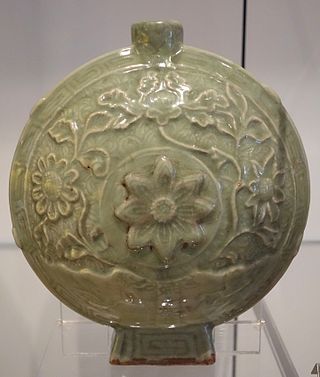
Longquan celadon is a type of green-glazed Chinese ceramic, known in the West as celadon or greenware, produced from about 950 to 1550. The kilns were mostly in Lishui prefecture in southwestern Zhejiang Province in the south of China, and the north of Fujian Province. Overall a total of some 500 kilns have been discovered, making the Longquan celadon production area one of the largest historical ceramic producing areas in China. "Longquan-type" is increasingly preferred as a term, in recognition of this diversity, or simply "southern celadon", as there was also a large number of kilns in north China producing Yaozhou ware or other Northern Celadon wares. These are similar in many respects, but with significant differences to Longquan-type celadon, and their production rose and declined somewhat earlier.
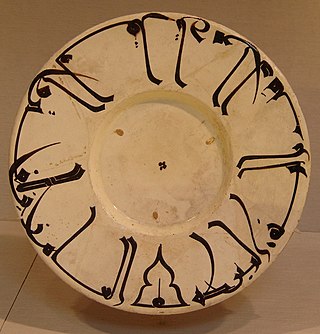
Earthenware is glazed or unglazed nonvitreous pottery that has normally been fired below 1,200 °C (2,190 °F). Basic earthenware, often called terracotta, absorbs liquids such as water. However, earthenware can be made impervious to liquids by coating it with a ceramic glaze, and such a process is used for the great majority of modern domestic earthenware. The main other important types of pottery are porcelain, bone china, and stoneware, all fired at high enough temperatures to vitrify. End applications include tableware and decorative ware such as figurines.

Stoneware is a broad term for pottery fired at a relatively high temperature. A modern definition is a vitreous or semi-vitreous ceramic made primarily from stoneware clay or non-refractory fire clay. End applications include tableware, decorative ware such as vases.

Pottery and porcelain is one of the oldest Japanese crafts and art forms, dating back to the Neolithic period. Kilns have produced earthenware, pottery, stoneware, glazed pottery, glazed stoneware, porcelain, and blue-and-white ware. Japan has an exceptionally long and successful history of ceramic production. Earthenwares were made as early as the Jōmon period, giving Japan one of the oldest ceramic traditions in the world. Japan is further distinguished by the unusual esteem that ceramics hold within its artistic tradition, owing to the enduring popularity of the tea ceremony.

Celadon is a term for pottery denoting both wares glazed in the jade green celadon color, also known as greenware or "green ware", and a type of transparent glaze, often with small cracks, that was first used on greenware, but later used on other porcelains. Celadon originated in China, though the term is purely European, and notable kilns such as the Longquan kiln in Zhejiang province are renowned for their celadon glazes. Celadon production later spread to other parts of East Asia, such as Japan and Korea, as well as Southeast Asian countries, such as Thailand. Eventually, European potteries produced some pieces, but it was never a major element there. Finer pieces are in porcelain, but both the color and the glaze can be produced in stoneware and earthenware. Most of the earlier Longquan celadon is on the border of stoneware and porcelain, meeting the Chinese but not the European definitions of porcelain.
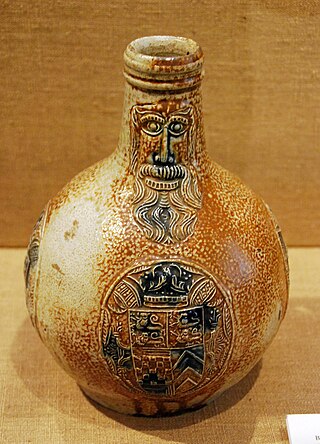
Salt-glaze or salt glaze pottery is pottery, usually stoneware, with a ceramic glaze of glossy, translucent and slightly orange-peel-like texture which was formed by throwing common salt into the kiln during the higher temperature part of the firing process. Sodium from the salt reacts with silica in the clay body to form a glassy coating of sodium silicate. The glaze may be colourless or may be coloured various shades of brown, blue, or purple.

Creamware is a cream-coloured refined earthenware with a lead glaze over a pale body, known in France as faïence fine, in the Netherlands as Engels porselein, and in Italy as terraglia inglese. It was created about 1750 by the potters of Staffordshire, England, who refined the materials and techniques of salt-glazed earthenware towards a finer, thinner, whiter body with a brilliant glassy lead glaze, which proved so ideal for domestic ware that it supplanted white salt-glaze wares by about 1780. It was popular until the 1840s.

Islamic pottery occupied a geographical position between Chinese ceramics, and the pottery of the Byzantine Empire and Europe. For most of the period, it made great aesthetic achievements and influence as well, influencing Byzantium and Europe. The use of drinking and eating vessels in gold and silver, the ideal in ancient Rome and Persia as well as medieval Christian societies, is prohibited by the Hadiths, with the result that pottery and glass were used for tableware by Muslim elites, as pottery also was in China but was much rarer in Europe and Byzantium. In the same way, Islamic restrictions greatly discouraged figurative wall painting, encouraging the architectural use of schemes of decorative and often geometrically patterned titles, which are the most distinctive and original speciality of Islamic ceramics.

Studio pottery is pottery made by professional and amateur artists or artisans working alone or in small groups, making unique items or short runs. Typically, all stages of manufacture are carried out by the artists themselves. Studio pottery includes functional wares such as tableware and cookware, and non-functional wares such as sculpture, with vases and bowls covering the middle ground, often being used only for display. Studio potters can be referred to as ceramic artists, ceramists, ceramicists or as an artist who uses clay as a medium.
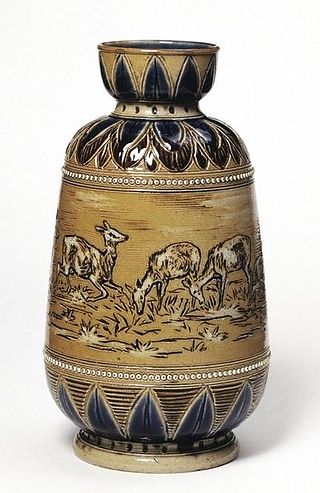
Royal Doulton is an English ceramic and home accessories manufacturer that was founded in 1815. Operating originally in Vauxhall, London, and later moving to Lambeth, in 1882 it opened a factory in Burslem, Stoke-on-Trent, in the centre of English pottery. From the start, the backbone of the business was a wide range of utilitarian wares, mostly stonewares, including storage jars, tankards and the like, and later extending to drain pipes, lavatories, water filters, electrical porcelain and other technical ceramics. From 1853 to 1901, its wares were marked Doulton & Co., then from 1901, when a royal warrant was given, Royal Doulton.

Chinese ceramics are one of the most significant forms of Chinese art and ceramics globally. They range from construction materials such as bricks and tiles, to hand-built pottery vessels fired in bonfires or kilns, to the sophisticated Chinese porcelain wares made for the imperial court and for export.

Sprigging or sprigged decoration is a technique for decorating pottery with low relief shapes made separately from the main body and applied to it before firing. Usually thin press moulded shapes are applied to greenware or bisque. The resulting pottery is termed sprigged ware, and the added piece is a "sprig". The technique may also be described by terms such as "applied relief decoration", especially in non-European pottery.

Art pottery is a term for pottery with artistic aspirations, made in relatively small quantities, mostly between about 1870 and 1930. Typically, sets of the usual tableware items are excluded from the term; instead the objects produced are mostly decorative vessels such as vases, jugs, bowls and the like which are sold singly. The term originated in the later 19th century, and is usually used only for pottery produced from that period onwards. It tends to be used for ceramics produced in factory conditions, but in relatively small quantities, using skilled workers, with at the least close supervision by a designer or some sort of artistic director. Studio pottery is a step up, supposed to be produced in even smaller quantities, with the hands-on participation of an artist-potter, who often performs all or most of the production stages. But the use of both terms can be elastic. Ceramic art is often a much wider term, covering all pottery that comes within the scope of art history, but "ceramic artist" is often used for hands-on artist potters in studio pottery.

John Philip Elers and his brother David Elers were Dutch silversmiths who came to England in the 1680s and turned into potters. The Elers brothers were important innovators in English pottery, bringing redware or unglazed stoneware to Staffordshire pottery. Arguably they were the first producers of "fine pottery" in North Staffordshire, and although their own operations were not financially successful, they seem to have had a considerable influence on the following generation, who led the explosive growth of the industry in the 18th century.
The Rye Pottery is a pottery in Rye, East Sussex, England, known as the Cadborough Pottery or "Rye Pottery" from its beginnings in c. 1834 to 1876, and Belle Vue Pottery from 1869 until it closed in 1939. It was revived as the "Rye pottery" in 1947 by the brothers Walter and John Cole, who became known for their tinglazed wares. During the 19th and early 20th centuries it produced earthenware in a distinctive style of sprigged applied relief decoration, sometimes supplemented by inscriptions using printer's type, which was marketed as "Sussex Rustic Ware". Often the texture of surfaces imitated tree bark. From c. 1840 to 1930 it was owned by members of the Mitchell family.
Sueharu Fukami is a Japanese ceramic artist and sculptor known for his work in pale-blue qinbai porcelain. Fukami's abstracted, sculptural ceramic works depart from the traditional Japanese artisan traditions of his upbringing and instead explore natural phenomena and universal senses like "infinite space" through sharp silhouettes, sweeping curves, architecturally-inspired arches, and delicately-colored glaze. His minimalist approach to porcelains has contributed to defining and expanding the meaning, importance, and popularity of contemporary Japanese ceramics beyond craft art circles, most notably to fine art collectors and museums globally.

Redware as a single word is a term for at least two types of pottery of the last few centuries, in Europe and North America. Red ware as two words is a term used for pottery, mostly by archaeologists, found in a very wide range of places. However, these distinct usages are not always adhered to, especially when referring to the many different types of pre-colonial red wares in the Americas, which may be called "redware".
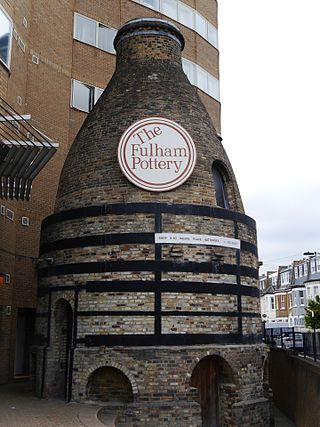
The Fulham Pottery was founded in Fulham, London, by John Dwight in 1672, at the junction of New King's Road and Burlington Road, Fulham, not far from Putney Bridge. Dwight is the earliest clearly documented maker of stoneware in England, although immigrant Dutch or German potters were probably active several decades before. By 1690 there was a rival stoneware operation in Fulham, run by the Dutch Elers brothers, who after a few years went off to become important early figures in transforming the Staffordshire pottery industry.

Ceramic art is art made from ceramic materials, including clay. It may take varied forms, including artistic pottery, including tableware, tiles, figurines and other sculpture. As one of the plastic arts, ceramic art is a visual art. While some ceramics are considered fine art, such as pottery or sculpture, most are considered to be decorative, industrial or applied art objects. Ceramic art can be created by one person or by a group, in a pottery or a ceramic factory with a group designing and manufacturing the artware.

Auguste Delaherche was a French ceramicist, who was a leading figure in French art pottery through the Art Nouveau period. Like other leading French potters of the period, he was intensely interested in ceramic glaze effects of colour and surface texture. He began his career making stoneware, but later also made porcelain in his studio.
This article incorporates text from a publication now in the public domain : Chisholm, Hugh, ed. (1911). "Dwight, John". Encyclopædia Britannica (11th ed.). Cambridge University Press.